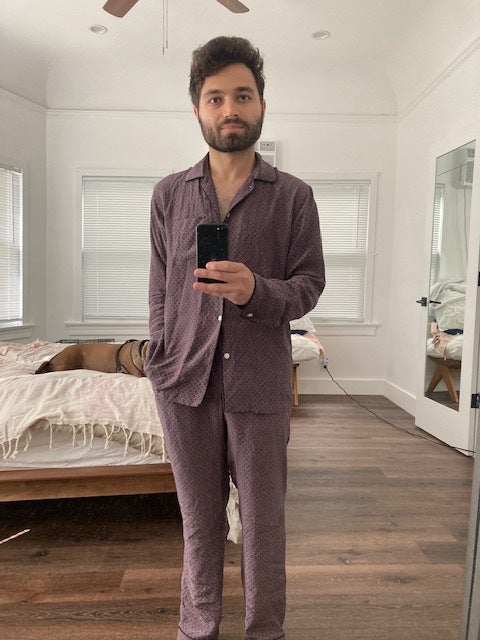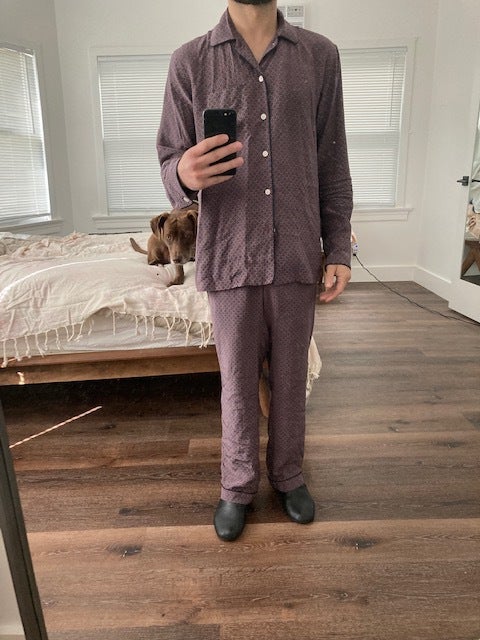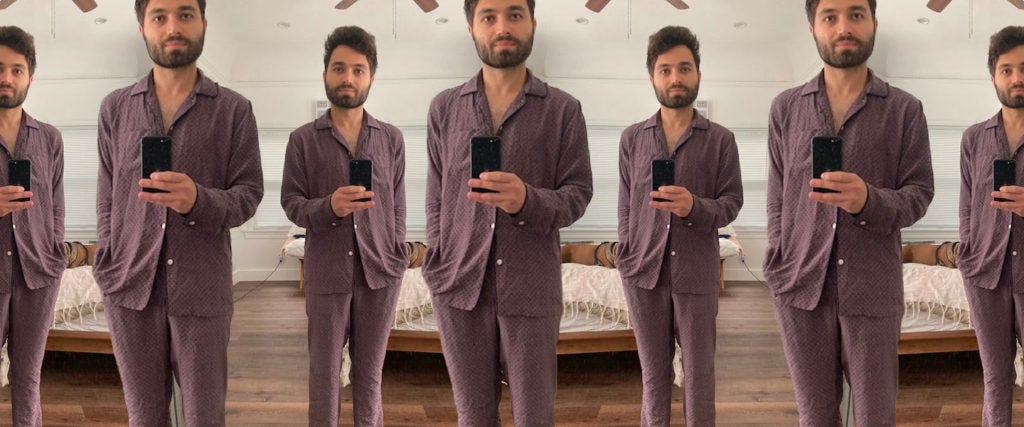“How many more nights are you going to wear those things to bed?” my girlfriend, Sunny, asked me.
I’d worn pajamas four nights in a row. It was clear by her tone — the same one she uses when I leave water splattered around the bathroom sink — that she wasn’t a fan of my 1950s-era sleeping attire.
The tension over sleepwear began in 2018, when a few months after we began dating and sharing the same bed, the review site Mattress Advisor released the results of a 1,000 person survey. They found that, compared to Boomers, millennials prefer sleeping in the nude. But the headline, which we both read and quickly accepted as scripture, proclaimed that couples who slept naked together were also more intimate with each other.
We took this to mean that skin-to-skin contact equals more sex and, per any number of studies, more sex equals happier, healthier relationships. In retrospect, the entire calculus, even if true, is embarrassingly trite. But in our defense, we were two newly-in-love twentysomethings with divorced parents. And we were both, in our own way, carrying that bag of spiders around with us as we navigated our relationship in bloom.
All of which is to say, on that cool Southern California night last month, the pajamas that I’d purchased to find out if they’d help me sleep better, were also, as far as Sunny was concerned, a betrayal. But apart from the data around pajamas and uninterrupted sleep, I was also intrigued by the momentum formal sleepwear has appeared to gain over the last several years. So much so that a number of new luxury pajama brands have hit the market — even surf label Stussy has joined the pajama club.
Thus, I set out to wear pajamas to bed for a full month to see what all the fuss was about.

The Recent Trend
For the better part of a decade, people who do the same thing I do — string together words on the internet — have been trying to make pajamas happen. “Pajamas are on the rise,” then Slate columnist Farhad Manjoo emphatically wrote in 2012. In his piece advocating for, and in defense of, pajamas, Manjoo suggested that “pajamas function as a great leveler — a way to bridge the gap between rich and poor, old and young, thin and fat.”
A year later, the New York Times’ Style section took a new approach. Pajamas aren’t just for bed; they’re for the streets too. “It’s my lady Hugh Hefner work look,” Rachel Wang, then fashion editor at Nylon told the Times. By August, 2015, the Wall Street Journal had to ask: Do men really wear pajamas to bed?
Of course, some do. Mid-quarantine, we covered how men were donning PJs during the pandemic as part of a new trend that was less “chauvinist boys’ club” and more “himbo rights.” And just last month, GQ offered their list of the best men’s pajamas that are “made for more than just lounging.”
Not all the fuss around pajamas has been positive, however. In 2013, conservative pundit Rich Lowry aimed his sword at a stock photo of a boy the Obama administration chose for a health-care PSA. The photo-turned-meme became known as “pajama boy,” and for Lowry and other conservatives, it was yet another distillation of winnowing masculinity and “a liberal’s overreliance on a paternalistic government,” according to Noreen Malone for The New Republic.
Never mind that the infant mortality rate in the U.S. continues to be the highest among countries with the same GDP, or that, since 2016, life expectancy in this country declined to its lowest level in nearly two decades. For the habitually nostalgic, pajamas worn outside the bedroom was the blinking red light: The American empire was officially crumbling.
The History of Pajamas
In one way or another, pajamas have been a symbol of status since their inception in Western culture. Under the British empire, colonists who observed the lightweight drawstring pants worn among Indians returned to England and began to pair their pants with a matching jacket rather than a nightshirt. As such, early pajama designs were heavily influenced by the rest of the world, Debbie Sessions of the clothing site Vintage Dancer previously told my colleague Brian VanHooker. By the 1930s, pajamas would draw inspiration from Russian military wear. And in the 1950s, “the fancy pajamas were being replaced by the comfortable, casual pajama made of knit-stretch fabrics on top and thin, cotton broadcloth bottoms,” Sessions explained.
Why We Stopped Wearing Them
As the 1950s dress code for men began to erode, so too did men’s affinity for formal loungewear, according to design historian Jennifer Grayer Moore. “From the 1970s and 1980s onward, men would more likely come home and roll into a pair of track pants or shorts. There wasn’t that much reason to change again after that,” Moore explained to VanHooker. “We now eat dinner in front of the TV and talk on our phones while we’re on the toilet, which breaks all kinds of rules of decorum.”
Nonetheless, just because men stopped wearing pajamas to bed doesn’t mean pajamas disappeared from the culture. Pajamas — once the personification of wealth and status — began to signify something else entirely: laziness. Just last month, the New York Times reported on a school district in Springfield, Illinois, that effectively banned students from wearing pajamas during Zoom class. Again, one would think there are more important issues than students wearing pajamas during remote learning. But as was the case with “pajama boy” in 2013, it’s easier for political pundits to generate faux outrage out of students comfortably Zooming into class in sleepwear than it is to issue a tax credit so that parents can have more time to help their kids get ready for school.
Does the Material Matter?
For my own experiment, I opted to wear a two-piece set of pajamas to bed and no place else. Admittedly, the pants made it to my workspace once or twice for my first meeting of the day over Zoom. Which is why the initial set of pajamas I bought were made of poplin, a lightweight cotton that keeps cool and washes easily in the machine. By contrast, silk, linen and wool — other common fabrics for pajamas — ought to be dry cleaned or at minimum washed by hand. Nonetheless, after just five minutes of standing around in my poplin pajamas, I realized that even light cotton wasn’t going to work for me. They were so papery, I could hear the shirt shuffle when I moved. It was no different than a fresh Oxford button-down. The set cost $260, and it felt like I was dressed in a not-all-the-way-there suit — definitely not something that was going to make it easier to get a good night’s sleep.
In 2019, Chin Moi Chow, director of the Sleep Research Team at the University of Sydney, led a study on which sleepwear fabric induces the best night of sleep. “Sleep disturbance in adults with no health concerns is often linked to the thermal environment,” says Chow. “Individual fabrics have different fiber properties, which can influence thermal comfort due to their ability to buffer heat and moisture.” From her study, Chow found that sleep was significantly less fragmented when participants wore wool compared to polyester, and somewhat less fragmented when they compared wearing wool to cotton.
Why wool? Per Chow, wool’s fiber properties create an environment that contributes to the regulation of thermal comfort. “Wool fibers’ natural crimp structure helps trap air pockets within the fabric, thus offering a buffer for heat exchange (whether hot or cold),” she says. Wool’s unique ability to draw moisture away from the skin also helps stabilize the microclimate temperature and relative humidity in the space between your skin and your bedding.
What I Learned
In spite of Chow’s insistence that wool pajamas, particularly when worn in cooler temperatures, contribute to deeper sleep, I returned my poplin pajamas for a set of silk ones. Again, I live in L.A., so it never stays that cold for long. Chow gave me her blessing. As long as they’re not polyester, she told me, I should still be able to notice a difference in the quality of my sleep.
I can attest, too, that it was the right decision. My Sleepy Jones silk pajama set, which costs nearly $300 (the middle to lower end of fancy sleepwear expense), is like wrapping yourself in better skin. From night one to the morning of day 31, these pajamas cascaded down my body like a sluice controlled by God. Every night, when I fastened the buttons while brushing my teeth, a little fairy appeared in the mirror and whispered, “It’s bedtime sweety.”

Really — and I can’t stress this enough — I’ve never worn something so comfortable. Every time I put them on, I felt like an archduke. That’s what fancy pajamas did to me: They made me feel regal in the most absurd way.
Still, that dumb survey from Mattress Advisor may have had it right all along. Over the course of my pajama-clad month, I had a lot of time to think about how my sleepwear affected the intimacy between Sunny and me. Not by how often we have sex, which seems no more or no less consistent to my pre-jama days. Instead, it’s the skin-to-skin contact that seems to have slowly slipped away.
Prior to the pajamas, Sunny says our attempts to touch or hold one another happened nearly every night. “Either you were cold, or I was cold,” she tells me. “It was just easier.” But during the pajama experiment? “Just not as much,” she says. After all, I was inside my own cocoon. It’s simple enough to drift apart when you’re sleeping. Throw a set of pajamas into the mix and two people become two islands. That said, I also slept deeply through the night, every night, with no interruptions.
Then, last night, for the first time in 31 days, I slept naked. I woke up around 3 a.m., something that hadn’t happened in weeks. It was still dark, but the shadows in Sunny and my bedroom were clear. To the left, my bunched-up silk pajamas beckoned from the top of my sock drawer. To the right, Sunny was sound asleep, the comforter spilling down the edge of her shoulder and her back turned slightly away. I checked my hands to make sure they weren’t cold. Then I closed my eyes and nudged my body in her direction as I pulled the blanket over the both of us.
It was easier, I thought, than getting out of bed.

